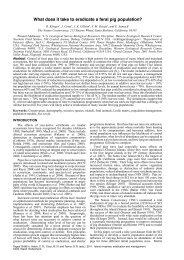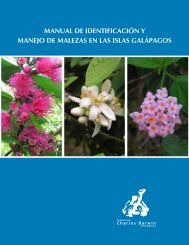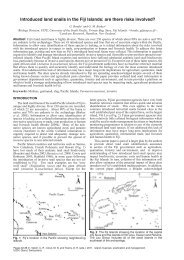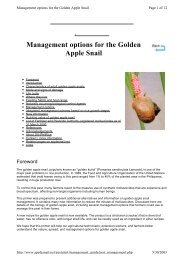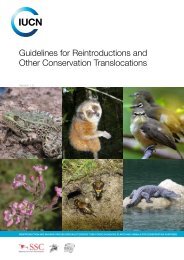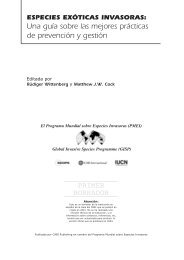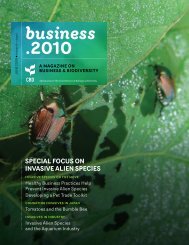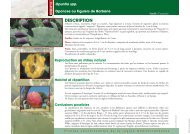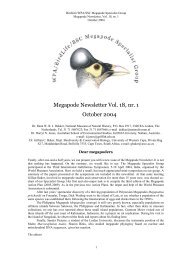Aliens Newsletter - ISSG
Aliens Newsletter - ISSG
Aliens Newsletter - ISSG
You also want an ePaper? Increase the reach of your titles
YUMPU automatically turns print PDFs into web optimized ePapers that Google loves.
Why this project?<br />
Chile and Argentina share an extremely valuable<br />
natural heritage in high latitudes of southern Patagonia<br />
and Tierra del Fuego which harbours some of<br />
the last of the wild ecosystems that exist in the<br />
Southern Cone, with relatively low levels of human<br />
impact (Figure 1). Outstanding examples of these<br />
ecosystems are the extended, continuous and primary<br />
Sub-Antarctic beach forests of Tierra del<br />
Fuego and the extended and unique peat bogs in the<br />
same region, which have a local and global significance<br />
for biodiversity conservation. Argentina and<br />
Chile also share the cultural heritage of that region,<br />
developed in a landscape marked by isolation, remoteness,<br />
harshness. Regardless of its remoteness,<br />
these distinctive environments are affected by<br />
global threats like the invasion of alien species<br />
among which the American beaver (Castor<br />
canadensis) is one of the most prominent.<br />
Beavers were brought from Canada and introduced<br />
near Fagnano Lake, Tierra del Fuego, in 1946 by the<br />
Argentinean Navy to establish a fur industry.<br />
Since then, their expansion covered around<br />
7,000,000 ha (Lizarralde 1993 in Parkes et al. 2008)<br />
including several islands like Isla Grande<br />
(4,810,000 ha), Navarino (252,800 ha), Dawson<br />
(200,000 ha), Nueva (12,000 ha), Lenox (17,000<br />
ha), and Picton (10,500 ha). In addition, part of the<br />
Hoste island (480,000 ha), and many other smaller<br />
islands south of the Strait of Magellan have been invaded<br />
by beavers (Parkes et al. 2008) (Figure 2).<br />
This semi-aquatic rodent lives in so called colonies<br />
(i.e., family groups) mainly occupying lodges<br />
along waterways where they build dams (Figure 3).<br />
They could also live in dens along river banks or<br />
lodges built along the shores of larger rivers, and<br />
even in lakes where they do not build dams (Parkes<br />
et al 2008). According to estimates, over 20,000 km<br />
of waterways are already invaded by the species and<br />
the vigorous expansion of the beaver population can<br />
be seen in Tierra del Fuego Island, where beaver’s<br />
occupancy is evidenced in almost 100% of the watersheds.<br />
The current population was estimated at<br />
65,000 individuals, assuming an average frequency<br />
of active colonies over the entire range of 0.5/km<br />
(Parkes et al. 2008). Beavers occupy all types of<br />
ecosystems, ranging from Andean prairies and<br />
forests to Patagonian steppes, being found from sea<br />
level up to about 650 m a.s.l. (Parkes et al. 2008).<br />
So far, the only barrier to invasion seems to be the<br />
large permanent snowed areas, as for example the<br />
ice fields that mantle Andean cordillera in Isla<br />
Grande de Tierra del Fuego (Parkes et al. 2008).<br />
However, beavers managed to cross the Strait of<br />
Magellan to reach the Brunswick Peninsula in mainland<br />
Chile, which has continued for sixteen years<br />
now (Soto Volkart 2006). Evidence shows that<br />
beaver invasion is currently a problem at a near<br />
“continental” or at least “sub-continental” scale.<br />
In Patagonia, the impacts of beavers greatly affect<br />
the functioning and structure of the ecosystems invaded.<br />
Beavers directly harm forest and other<br />
types of vegetation by consuming trees and other<br />
plants, but the most serious impacts are those derived<br />
by the damming of rivers and streams. Dam<br />
construction changes the hydrology of the entire<br />
watershed, transforming lentic ecosystems to lotic<br />
ones. As a result of beaver behaviour, Nothophagus<br />
forests along the riparian areas in Tierra del<br />
Fuego have been killed and replaced by beaver<br />
ponds and associated grassland-sedge dominated<br />
meadows (Lizarralde et al.2004, Anderson et al.<br />
2006, Martinez Pastur et al. 2006, Parkes et al.<br />
2008) (Figure 4).<br />
There is also evidence that these beaver meadows<br />
are prone to invasions by introduced weeds (Anderson<br />
et al. 2005 in Parkes et al. 2008). Chemical composition<br />
of once pristine waters, change dramatically<br />
after beaver impact (Lizarralde et al. 1996).<br />
Beaver effects on riverine environments in steppes<br />
and peat bogs are unknown, but changes in hydrology,<br />
erosion, and sediment accumulation could be<br />
significant. In summary, a beaver certainly have a<br />
significant impact on Southern Patagonia ecosystems<br />
and biological communities, primarily as a<br />
consequence of engineering but also, as Simberloff<br />
(2009) concludes, due to other effects derived from<br />
the invasive meltdown with other introduced<br />
species, thus threatening ecosystem’s functioning<br />
and persistence in the long term.<br />
<strong>Aliens</strong> 11



